SMART
- Secure Reliable Mulitcast for Advanced Repeating of Television
World
Multicast has defined the necessary tools needed to overcome the
challenges associated with IP Multicast. The SMART
routers are dynamic and use
both SIMPLE (Self Implementing
Multicast Protocol Level Escalation) and SMART
(Secure Reliable Multicast for Advanced Repeating of Television)

SMART
is a complete set of tools for advanced
Multicast routing on the Public Internet and private intranet.
Why
do we need SMART?
We need SMART because the current Internet infrastructure has no
mechanism to allow for security and reliability
to be integrated into a
single system. There are several reliable IP Multicast schemes
currently developed but they all have failure points, for example:
PGM – Pretty Good Multicast suffers
from several fatal issues -
The model has a difficult time scaling efficiently to large audiences
because it re-Multicasts missing information. For example, if a network
had one thousand listeners and packet loss was different at each
location, the PGM master server would have to re-multicast the missing
information to all clients, meaning that all clients would suffer the
bandwidth loss for packet replacement for the whole group of
users. A 500kbs signal could easily take a megabit (or more)
of data to the end
user in a PGM world. Also, PGM fails on Radio LANS
because radio LANS suffer from tremendous packet out of
order.
PGM re-Multicasts the missing information and that re-Multicast is NOT
reliable, meaning if a user missed the original Multicast packet - and
then missed the re-Multicast - the packet would be lost.
FEC - Forward Error Correction also has fatal
issues (for live streaming media) – There are
several forward error correcting Multicast schemes currently in use.
These work reasonably well for their intended design, which is file
transfer. The current leaders in this field are KENCAST and
DIGITAL FOUNTAIN. For companies that attempt to accomplish
streaming reliability using FEC, one can expect long delays during
channel switch (latency), and high data rates are necessary to support
noisy environments where packet loss occurs more frequently.
The spread spectrum FEC implementors need to use as much as
10 times more redundant
data to Multicast on a simple home radio LAN without picture distortion.
On
the fly Repair - NAK Based Tree
World Multicast accomplished the goal of real time error recovery by
removing inefficiencies in the way computers poll their communication
“sockets”. This allows us to do "on the fly" packet
repair.
Beyond
the scope - There are a myriad of challanges
we had to overcome to make a SMART Secure Reliable IP Multicast
work that are far beyond the scope of this document.
When
do we use SMART?
We use SMART any time we want to accomplish Secure Reliable IP
Multicast where the reception of the signal is critical.
SMART can be used for more than just Television signals. The tools
set can be used for any point to multi-point distribution of data
where security and reliability are important.
Where
do we install software?
We install SMART software at the edges of the signal
path.
To increase reliability and scale we can install SMART software in the
middle of the signal path.
WMI
Player
The WMI Player is "white label" (branded to your company) and has these elements
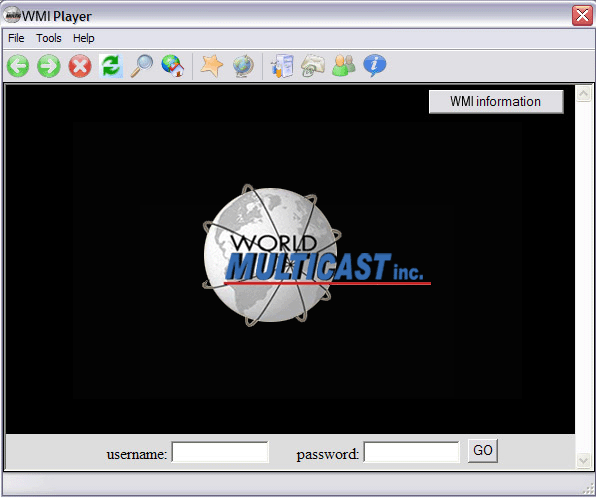
The main
player is defined with a friendly familiar user interface. The Player
has been defined with an embedded browser. The software has
an embedded Internet Explorer browser on Windows, Safari
browser on Mac, and Firefox browser on Linux / Unix. Because
of
the Linux / Unix compatibility the software is a perfect fit for
IPSTB's. All versions have customizable buttons for easy access to
banking, email, shopping, media links, channel (network) additions
& previews.
Player
remote
 |
The player remote
definition allows for login using the box just underneath the
Service Name.
Different services can be defined using this option. Pulling down the
box allows the user to be steered through the login procedure. The
login procedure obtains the user's preferences (pre-selected network
channels) to be loaded from a database using a complex query. The
definition of the complex query for these functions has previously
unheard of performance. The query definition is obtaining no graphic
information from a web server and the server is capable of responding
to massive amounts of queries. This system has been designed
and
tested to be scalable.
The player remote is
truly the center of the program for the end user in
SMART, as the thumb on the button truly feels like television on the
Internet. The
Remote also has a mute button for audio mute, channel up and down, stop and go, audio up and down.
The
Remote control responds to keystrokes after about ½ of a
second. The delay is to allow for multiple keys to be pressed in
selection of longer channel numbers. The length of
time the
remote waits is comparable with most cable and satellite controllers
now currently available. The bottom window of the remote
displays
the user sub-preferences e.g., Mom, Dad, Kids. These
sub-preferences are established using the embedded browser to log into a
web engine that allows the end user to choose channel line ups and set
preferences.
|
Installation
The WMI Player comes with an industry standard install script that can
be customized for area specific installs. The software is
defined
to be branded by Telco or Cable MSO/ISP’s for use in their
networks, so
the source has one build for all platforms. One set of source for
Linux, Mac OSX (Intel) and Windows NT and 2000. YES Windows Vista
is supported.
Download the Player software
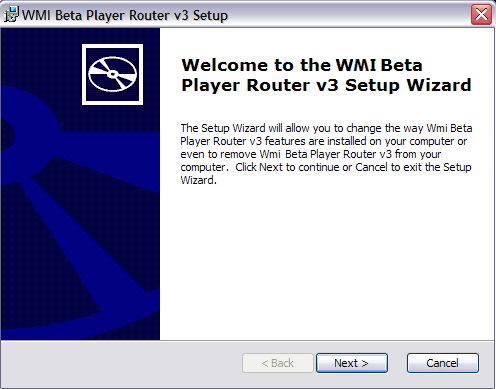
Configurations available for WMI Players
The Player main screen has been defined with Tools-> Options to
bring up the
player’s configuration dialog. The WMI Player is available in
two
configurations.
Version 1: The player does not support STUBBY SMART END NODE in the
player. This player is optimal for use in a wired environment. Version
2 of the player can be configured to support wire environments and it
is anticipated that it will obsolete version 1.
Version 2: The player supports STUBBY SMART END NODE in the player and
includes SMART ABT. SMART ABT is an accelerated buffering technology
that uses a Unicast as well as the IP Multicast to fill the buffer in
an accelerated fashion. This allows for faster channels switching times
while still allowing for extended buffering for SMART
operation.
SMART is necessary for 802.x radio LAN function because of packet loss
on radio LANS. UDP packet loss is almost non-existent on home
Ethernet networks, but the radio LAN environment relies heavily on TCP
for reliable operation. Packet loss and packet out-of-order is the main
reason that Radio LANS function at such reduced efficiency compared to
wired environments. SMART has special algorithms tuned for
Radio
LAN performance that increase the efficiency of streaming media
compared to TCP. This increase can be rather dramatic
depending
on the quality of the signal.
Version 3: In this version the player imputes the router and player
engine into a single application that supports STUBBY SMART END NODE
directly in the player. Version 3 also plays commercial insertion
directly from the end users hard disk.
Configuration defined for Version 1
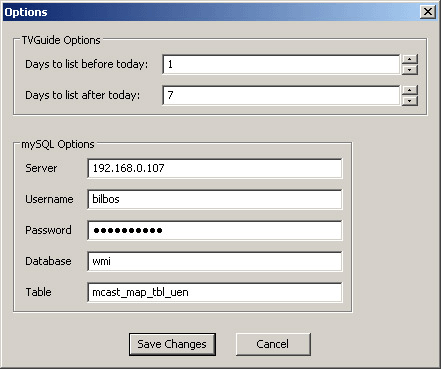
TVGuide Options
Days to list before today: This is the number of days that
you
wish to pull from the MySql server before today (the system date of
your computer). Generally this would be zero days before today.
Days to list after today: This is the number of days that you wish to
pull from the MySql server after today (the system date of your
computer). Generally this would be 7 days after today.
SQL Options
Server: The address of the Sql server (automatically set at
installation time). This can be updated by the user or with a
registry update program that can be created by a script and emailed to
end users in an automated fashion.
Username: The username for the Sql
account. This is
different from the user name and password that is SPECIFIC to each
user. These user accounts may be level specific, for specific
access or tailored to each market.
Password: The password for the Sql account. This is
different
from the password that is SPECIFIC to each user. These user
accounts may be level specific, for specific access or tailored to each
market.
Database: The database that contains the tables for user, programming
and area specific (multicast map tables).
Table : The name of the Multicast Map Table (MMT) to use for a specific
area.
Configuration for Version 2
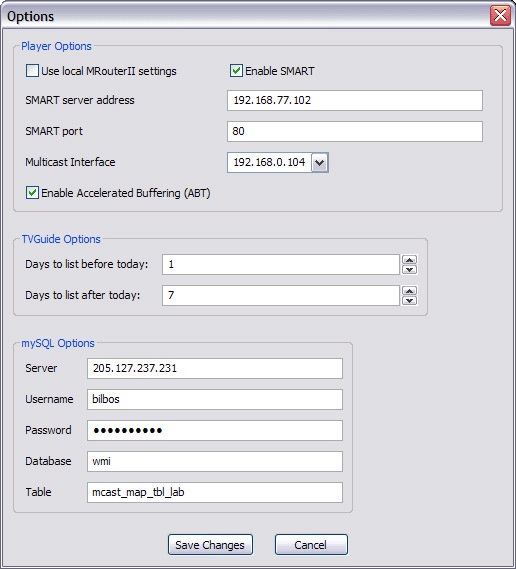
Player Options
Use
local Mrouter II settings. Select this option to use the local router
server address and port for the SMART server address and SMART port.
Enable SMART
Select the option to use SMART error correction. This is
necessary for Radio LANS and environments where secure reliable IP
Multicast is necessary.
SMART server address
This is the address of the smart server. In a private
network
this would generally be a hard wired box that functions as the
localized server for packet replacement .
SMART port
This is the port for the server. We generally configure this to port 80
so as not to interfere with firewall activity etc.
But if a
web server is operating on the local box that has the SMART server on
it this can be changed in the player and must also be changed in the
server.
Multicast Interface
If the computer has more than one network interface use this box to
select the interface where the Multicast would appear (note: This is
the interface that contains the network of the SMART Multicast END NODE)
Enable Accelerated
Buffering Technology (ABT)
Enables the
accelerated buffering of channel changing, allowing the
channel change to occur at a higher rate (less waiting time between
channel changes). ABT is especially helpful if SMART is enabled because
of the extra buffering required by SMART, which can cause additional delay of
the channel switching time.
Days to list before
today: This defines the number of days that you
wish to pull from the MySql server before today (the system date of
your computer). Generally this would be zero days before today.
Days to list after
today: This defines the number of days that you wish to
pull from the MySql server after today (the system date of your
computer). Generally this would be 7 days after today.
SQL Options
Server: The address of the Sql server (automatically set at
installation time). This can be updated by the user or with a
registry update program that can be created by a script and emailed to
end users in an automated fashion.
Username: The username for the Sql
account. This is
different from the user name and password that is SPECIFIC to each
user. These user accounts may be level specific, for specific
access or tailored to each market.
Password: The password for the Sql account. This is
different
from the password that is SPECIFIC to each user. These user
accounts may be level specific, for specific access or tailored to each
market.
Database: The database that contains the tables for user, programming
and area specific (multicast map tables).
Table : The name of the Multicast Map Table (MMT) to use for a specific
area.
TV Guide
The
TV Guide is integrated into the WMI Player. It has been
defined
to allow time shift and localized insertion (version 3) .
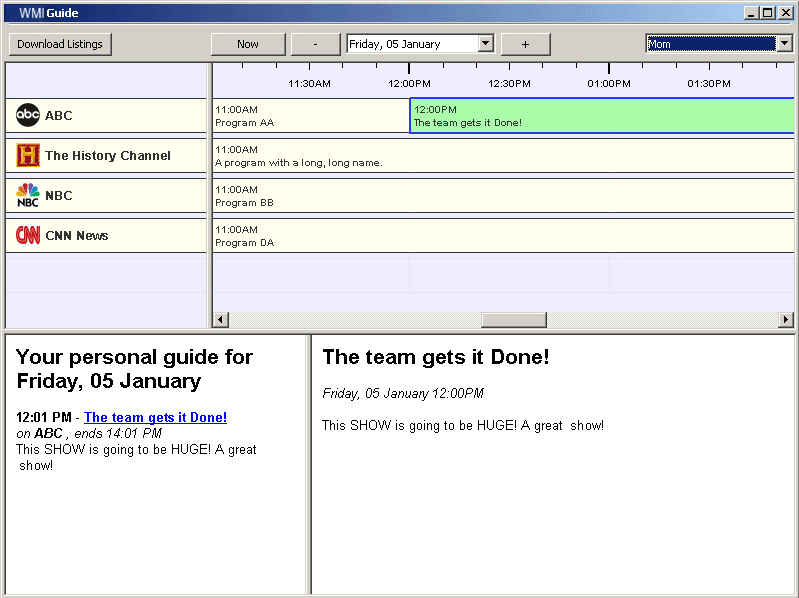
The
data is pulled from the server in a glob and then cached locally
in memory for scrolling by the TvGuide users. SCROLLING is accomplished
at previously unheard of speed. Channels selected that are out
of range produce an error code. Channels are mapped to end
users in logical (1, 2, 3, 4) order from what may have been 998
321 121, so the end user is presented with his or her custom built
service. Each channel is dynamic, and channels are added using
the embeded browser invoking an active web page routine.
|


